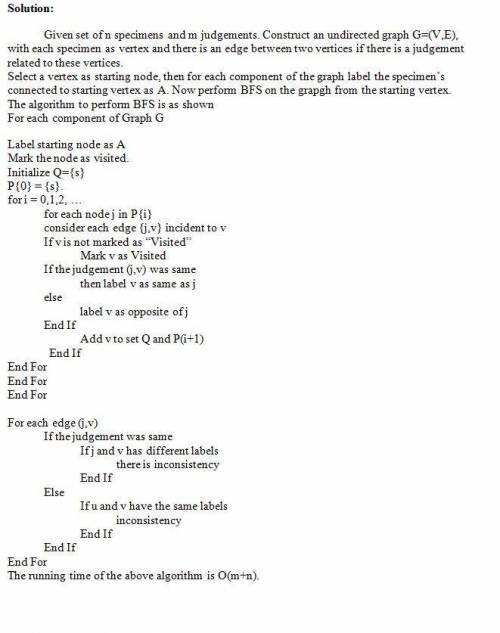
Engineering, 07.03.2020 03:32, surfer89
Inspired by the example of that great Cornellian, VladimirNabokov, some of your friends have become amateur lepidopterists (they study butter- flies). Often when they return from a trip with specimens of butterflies, it is very difficult for them to tell how many distinct species they’ve caught—thanks to the fact that many species look very similar to one another.
One day they return with n butterflies, and they believe that each belongs to one of two different species, which we’ll call A and B for purposes of this discussion. They’d like to divide the n specimens into two groups—those that belong to A and those that belong to B—but it’s very hard for them to directly label any one specimen. So they decide to adopt the following approach.
For each pair of specimens i and j, they study them carefully side by side. If they’re confident enough in their judgment, then they label the pair (i, j) either "same" (meaning they believe them both to come from the same species) or "different" (meaning they believe them to come from different species). They also have the option of rendering no judgment on a given pair, in which case we’ll call the pair ambiguous.
So now they have the collection of n specimens, as well as a collection of m judgments (either "same" or "different") for the pairs that were not declared to be ambiguous. They’d like to know if this data is consistent with the idea that each butterfly is from one of species A or B. So more concretely, we’ll declare the m judgments to be consistent if it is possible to label each specimen either A or B in such a way that for each pair (i, j) labeled "same," it is the case that i and j have the same label; and for each pair (i, j) labeled "different," it is the case that i and j have different labels. They’re in the middle of tediously working out whether their judgments are consistent, when one of them realizes that you probably have an algorithm that would answer this question right away.
Give an algorithm with running time O(m + n) that determines whether the m judgments are consistent.

Answers: 1
Other questions on the subject: Engineering

Engineering, 03.07.2019 14:10, makaylashrout77
Amass of 1.5 kg of air at 120 kpa and 24°c is contained in a gas-tight, frictionless piston-cylinder device. the air is now compressed to a final pressure of 720 kpa. during the process, heat is transferred from the air such that the temperature inside the cylinder remains constant. calculate the boundary work input during this process.
Answers: 2

Engineering, 04.07.2019 18:10, lillygrl100
For the closed feedwater heater below, feedwater enters state 3 at a pressure of 2000 psia and temperature of 420 °f at a rate of ix10 ibhr. the feedwat extracted steam enters state 1 at a pressure of 1000 psia and enthalpy of 1500 btu/lbm. the extracted er leaves at an enthalpy of 528.7 btu/lbm steam leaves as a saturated liquid. (16) a) determine the mass flow rate of the extraction steam used to heat the feedwater (10) b) determine the terminal temperature difference of the closed feedwater heater
Answers: 3

Engineering, 04.07.2019 18:10, oliviasoreo92
Compute the pressure drop of 30°c air flowing with a mean velocity of 8 m/s in a circular sheet-metal duct 300 mm in diameter and 15 m long. use a friction factor, f 0.02, and pair = 1.1644 kg/m a. 37.26 pa b. 25.27 pa n c. 29.34 pa d. 30.52 pa
Answers: 1

Engineering, 04.07.2019 18:20, alexis9263
Have a greater impact on maintenance productivity than any other support group. (clo5) a)-the top management b)-inventory and purchasing c)-sub-contracting d)-cmms
Answers: 2
Do you know the correct answer?
Inspired by the example of that great Cornellian, VladimirNabokov, some of your friends have become...
Questions in other subjects:

Mathematics, 02.08.2019 07:30

Social Studies, 02.08.2019 07:30

Mathematics, 02.08.2019 07:30




Mathematics, 02.08.2019 07:30

Chemistry, 02.08.2019 07:30


Mathematics, 02.08.2019 07:30







